What's going on with swap spreads

Coolabah Capital
The recent widening of Australian swap spreads (defined below) has taken them to their widest level since mid-2015.
Spreads are currently wider than the previous record wides since the introduction of centralised clearing of swaps in 2015, which caused a structural tightening in swap spreads as bank counterparty credit risk was eliminated. In this note we look at the drivers of this widening and conclude that bond scarcity is the main influence.
Bond scarcity will change dramatically in 2022. The RBA will end quantitative easing in first half 2022, so gross bond supply will increase by around $200 billion to more than $110 billion in calendar year 2022. It follows that 10 year spreads are likely to tighten.
We see fair value for 10 year swap spreads at 20 basis points, declining to 13bps, as gross issuance and repo financing conditions normalise. The market will likely get ahead of the change in gross bond supply by pricing it prior to the end of QE.
What is a swap spread?
Swap spreads are accessible to anyone who is comfortable with basic arithmetic — they are simply the difference between yields on Commonwealth Government bonds and interest rate swaps of similar maturities.
An interest rate swap is the market’s estimate of where the three-month bank bill swap rate or six-month bank bill swap rate will be on average over the next, say, three, five or 10 years.
The three- or six-month bank bill swap rate is the cost at which banks borrow money over these short maturities. The spread between BBSW and the market’s estimate of the RBA cash rate over the same time horizon is known as Bills/OIS spread, where OIS denotes the Overnight Indexed Swap rate that reflects market estimates of the RBA cash rate over different horizons.
The convention, when talking about swap spreads, is the swap yield minus the Commonwealth Government bond (henceforth “bond”) yield. A positive spread means the bond yield is below the swap yield.
In Australia, the market trades with reference to the yield of a futures contract, rather than a physical bond, so the 10 year swap spread is the difference between the 10 year swap yield and the yield of the 10 year bond future.
The design of the 10 year bond futures contract makes things a little more technical. Yet in the context of the current moves these technicalities are relatively unimportant.
Broadly speaking, the difference between swap yields and bond-future yields can be divided into three parts:
-
Bank credit is the difference between the Interest Rate Swap yield and the expected risk-free rate (in this case we use Overnight Index Swaps, or OIS, based on the RBA’s expected overnight cash rate). Banks generally borrow at a higher yield than the risk-free rate, so IRS yields are generally above OIS yields, reflecting the cost of bank funding. This spread is generally pro-cyclical, widening in bad times and tightening in good times.
-
Bond premium is the difference between the bond yield and the expected risk-free rate. Australian Government bonds have traded at both a discount and a premium to the risk-free rate over the past decade. When demand for Australian Government bonds is strong, their yields tend to be below the expected risk-free rate, and when demand slackens, their yield tends to rise relative to the expected risk free rate. Similarly, when supply increases bond yields tend to rise relative to OIS and when supply declines bond yields tend to decline relative to OIS.
-
Basis is the difference between bonds and bond futures. This is a combination of what’s technically known as the repo-forward (the difference between the current yield on the bonds and the forward rate at which you’d be indifferent between buying them now and later) and the bond-basket basis (the difference between the repo-forward and the yield on the bond future). Basis is typically small and has been the least important driver of swap spreads over the past few years.
How spreads have shifted
The past few years has been characterised by diverging bank-credit and bond-premium components of swap spreads.
During the post-COVID period, the bank-credit component of swap spreads first tightened and then widened, while the bond-premium component first declined and later increased. These divergent moves can be traced back to the fiscal and monetary policy responses to the crisis.
The initial response to COVID, highlighted by the green arrows in the below chart, was characterised by a tightening of the bank-credit component of spreads.
Surging bank deposits (due to cash payments to households and business), the RBA’s TFF, and a period of slow lending, reduced wholesale funding requirements, which caused bank-credit to tighten.
Meanwhile, a sharp increase in bond supply, to fund the fiscal-policy response, drove a marked cheapening of bonds (cheaper bonds = rising orange line).
The combination of tighter bank credit and cheaper bonds sent bonds above swap in mid-2020 (the orange line went above the blue line, so swap spreads were ‘negative’).
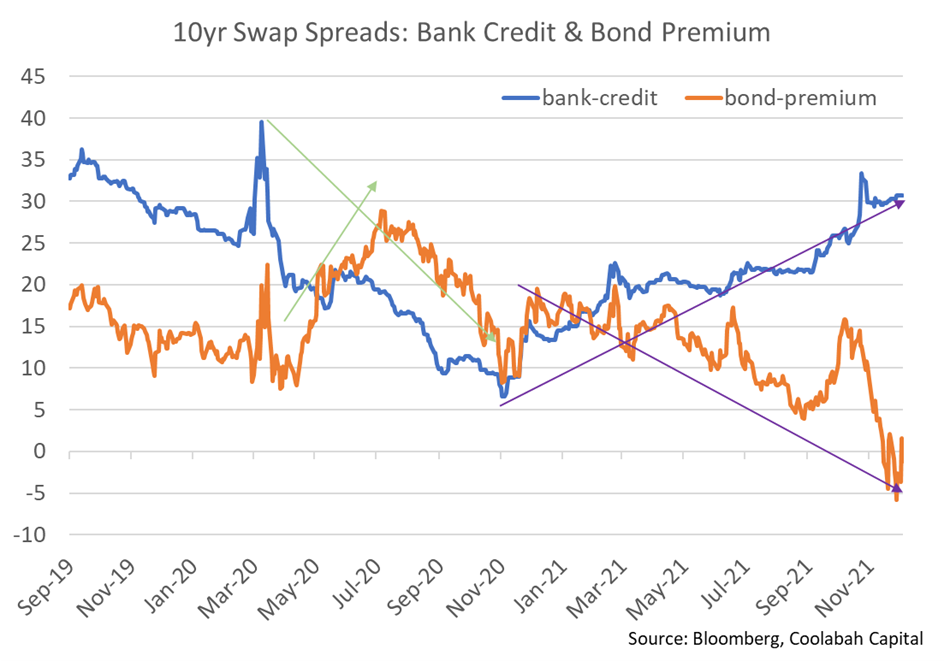
In the second phase, highlighted by the purple arrows, bank-credit normalised as both lending and bank funding arrangements went back to their pre-COVID norms.
The reduction in the net-supply of bonds, due to the RBA purchasing more bonds in their QE programs than the AOFM issued, changed the supply-demand balance in the bond market.
This caused a richening of the bond-premium (the orange line trends lower, following the purple arrow).
The combination of widening bank-credit and richening bonds led to a marked widening of swap spreads across 2021 (the blue line is above the orange line, so swap spreads are ‘positive’).
We see the same general patterns in three year swap spreads. First, a reduction of the bank-credit component and cheapening of bonds (cheapening = orange line higher) in first half 2020, reflecting the first phase of the policy response to COVID.
In the second phase, starting in second half 2020, bank-credit normalises as lending activity picks up and the RBA winds up their funding facilities, and bonds richen as RBA purchases reduce the supply of bonds.
Ongoing RBA buying has caused a sharp increase in both bond scarcity and volatility in this part of the curve (some of the recent volatility of the orange line is due to technical changes in bond futures basket from time to time).
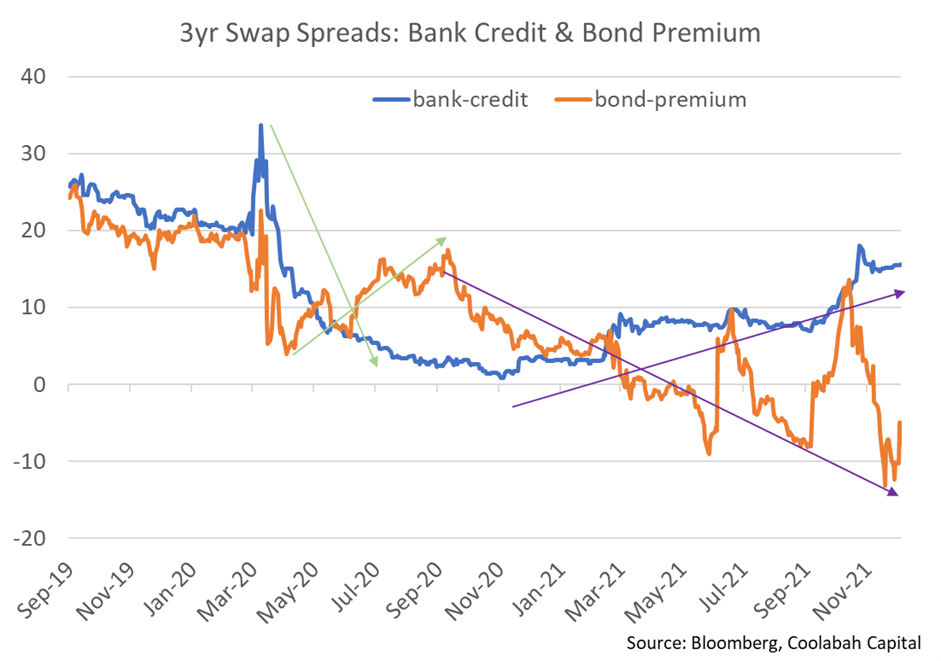
Are spreads extreme?
The bank credit component of swap spreads has largely normalised. The bond-premium component of swap spreads is around all time wides (bonds are expensive), but seems likely to normalise as the RBA ends QE, given that both gross- and net-supply will swing strongly positive in 2022.
At present, bank-credit spreads are around average: the 10 year spread is around average and the three year spread is a bit tighter than average. With the RBA’s balance sheet likely to remain very large until the latter part of this decade (the RBA owns over $70 billion of bonds that mature after 2030), excess ES balances will remain high, so three year bank credit will likely remain tighter-than-average.
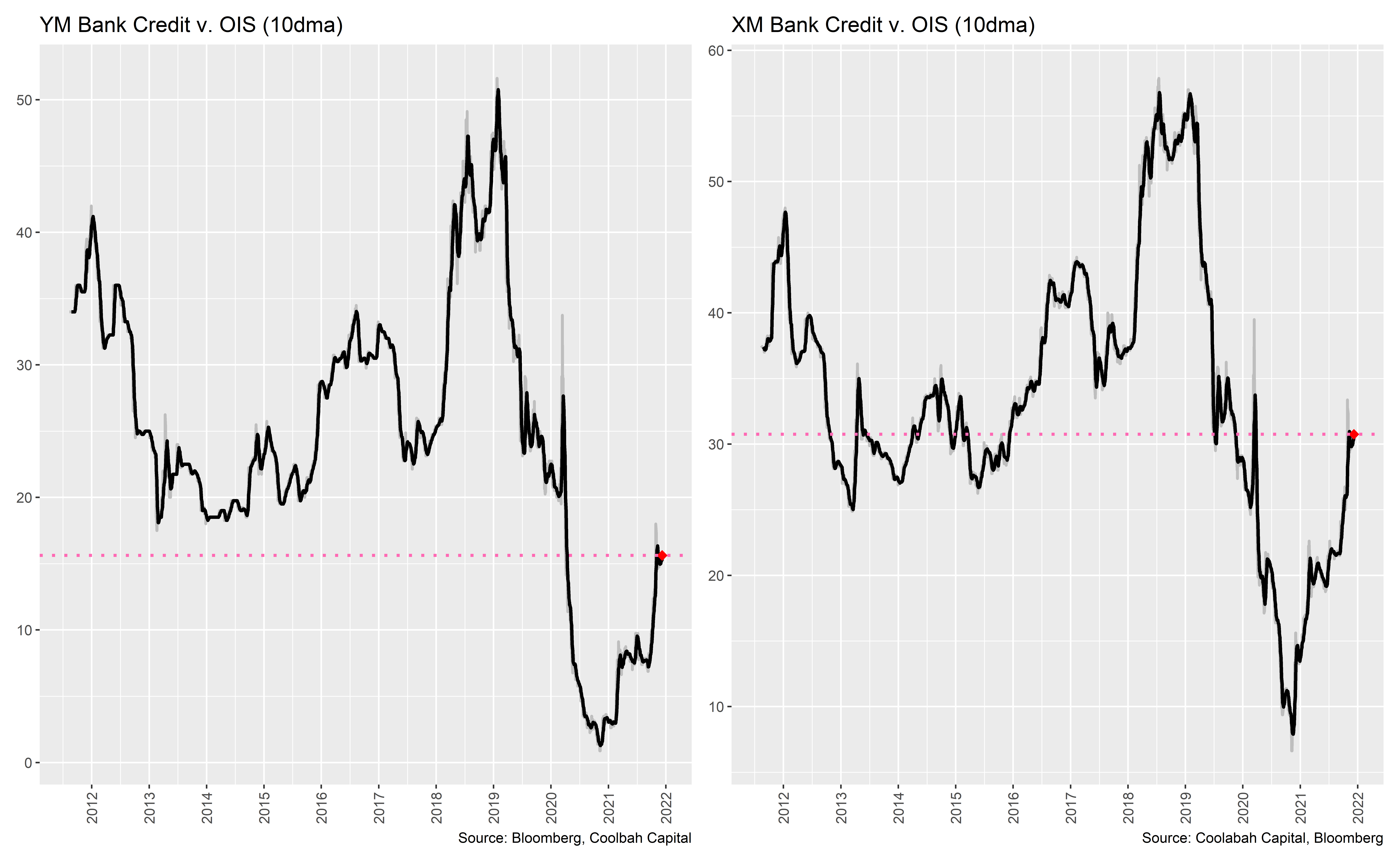
The lower-than average three year spread entirely reflects the currently high level of excess liquidity and tight starting point for short end bank credit (three month and six month bills versus OIS are more than 20bps below long run averages).
Forward starting measures, which reduce the influence of presently depressed short-term spreads, are around or a bit above long run averages (2y1y 3m bill v. OIS is ~24bps v. a long run average of 25bps; 5y5y 6m bill v. OIS is about 35bps versus a long run average of 32.5bps).
The most important variable influencing the bond-premium is the cost of repo financing. When repo funding is cheap (Repo-OIS basis is tight) bonds are cheap to finance and therefore tend to trade at a lower yield relative to OIS (this is a larger bond premium, so the orange line goes lower on the chart).
Conversely, when repo financing is expensive, the bond premium will decrease as bonds trade at a higher yield relative to OIS (this a smaller bond premium, so the orange line goes higher on the chart).
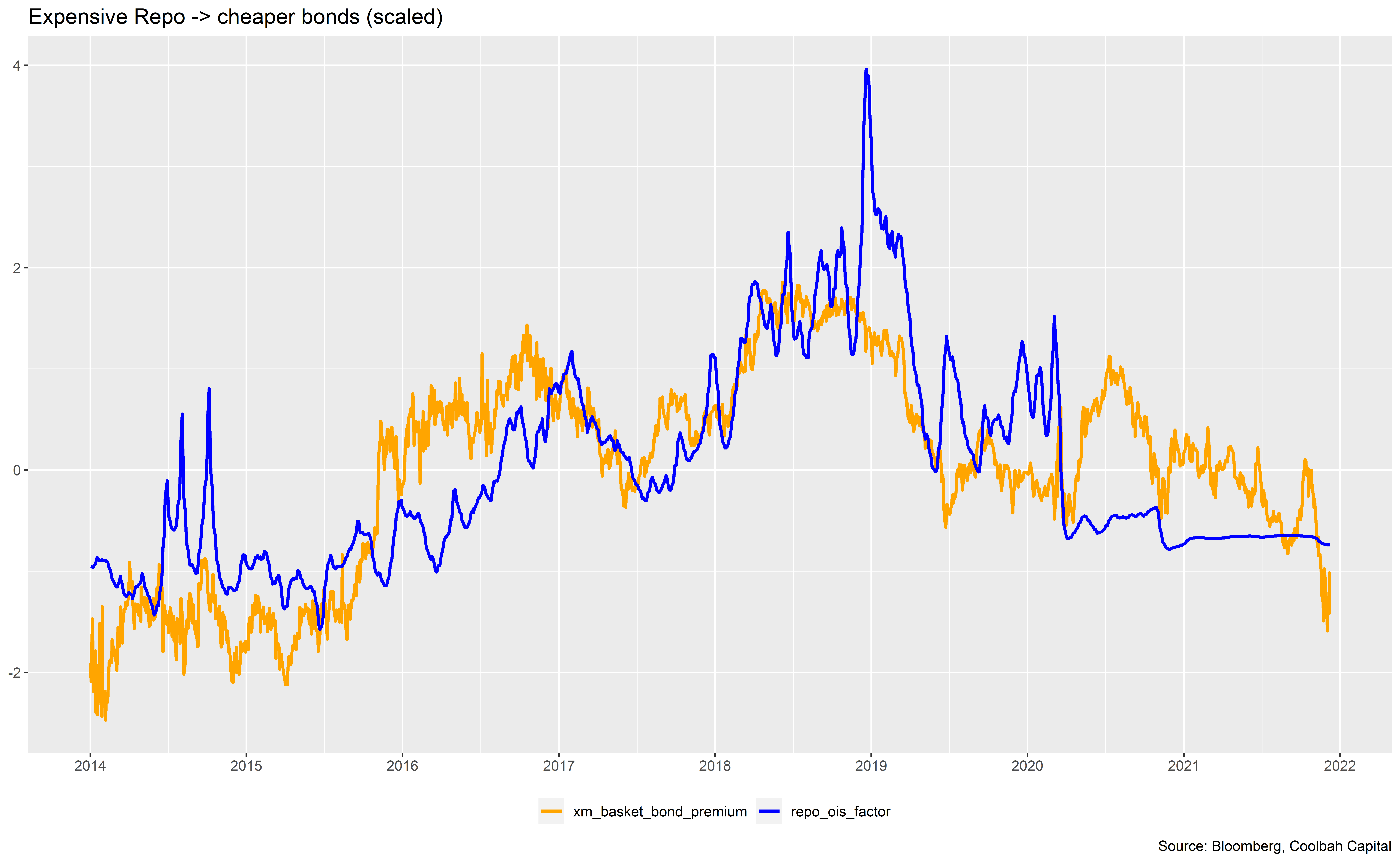
Repo funding in the interbank market has recently been cheaper than the RBA’s daily OMO (a side effect of QE) so our measure of the cost of repo financing may be biased up a little. This would be consistent with slightly wider swap spreads, though the bias is small.
After controlling for the effect of repo on the bond premium, there are three major divergences that are left to be explained:
-
A decrease in the government bond premium in 2015-16. The move to centralised clearing of swaps (away from bilateral clearing) reduced the credit risk of swaps. This meant that the government bond premium declined (the orange line rose in the above chart).
-
A decrease in the government bond premium in first half 2020. Bushfires and COVID boosted issuance in 2020. This drove a large cheapening of Australian Government bonds in first half 2020. The market is forward looking, so the market reacted to the expectation of more supply by cheapening bonds in anticipation of supply (note that the bond premium peaks before supply). In the model, we separately control for gross issuance (as a proportion of the market, adjusted for RBA buying) and the share of the market held by the RBA.
-
The large increase in the government bond premium in fourth-quarter 2021. The present richening of bonds is out of step with the cost of repo financing.
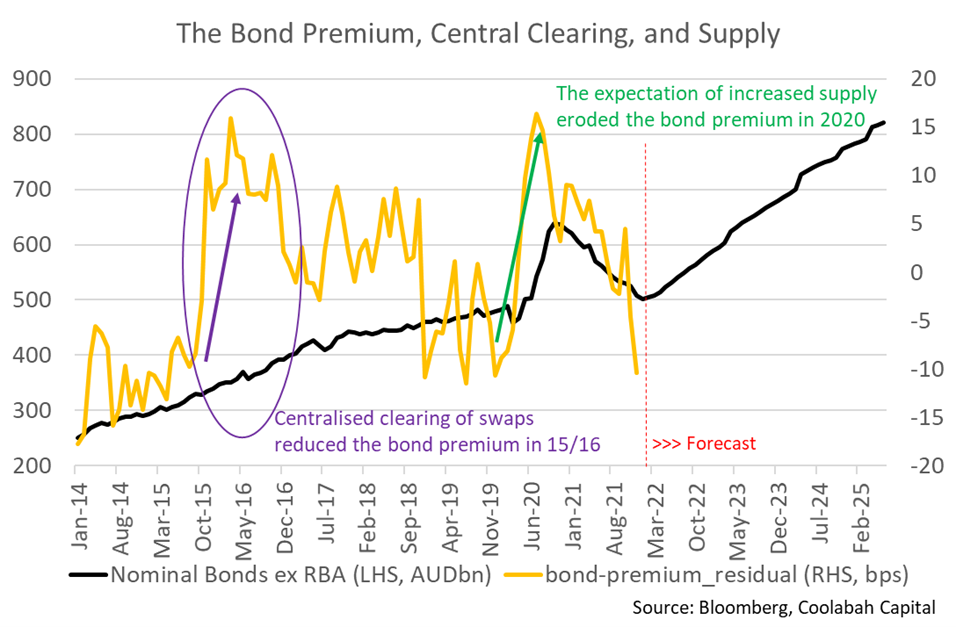
Bringing it all together
Most of the variation of 10 year swap spreads can be explained by a small number of fundamental variables:
-
Bank credit
-
The cost of repo finance
-
The gross issuance of bonds (as a share of the market, adjusted for RBA buying)
-
The RBA’s holdings as a share of nominal bond market
-
A structural break for the move to centralised clearing.
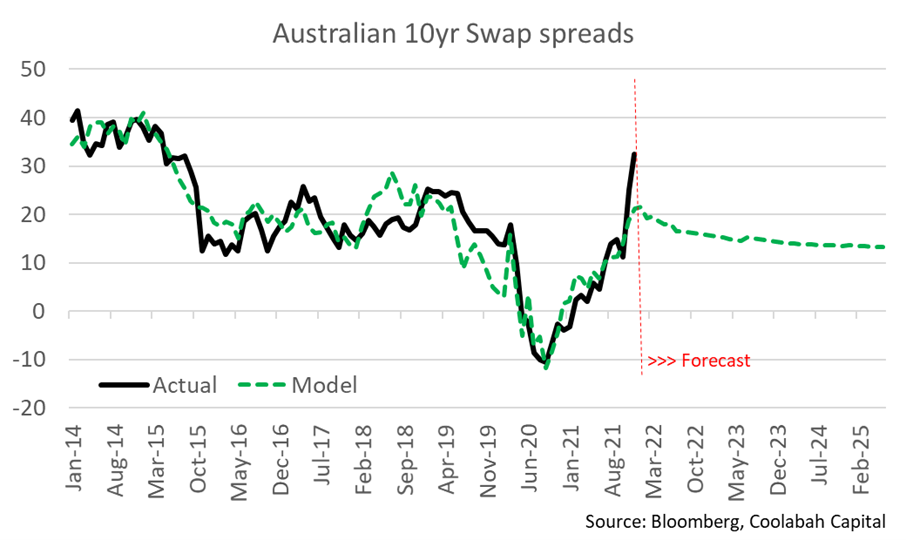
Based on this model, we find the 10 year swap spreads will average about 15bps over the next few years. In calculating this, we assume the RBA concludes QE in first half 2022 (we have assumed they taper from the present $4 billion per week by stepping down $1 billion per month to end the program in May), that the AOFM issues broadly in line with published budget numbers (we have assumed a $30 billion improvement in 2021-22, and a further $30 billion improvement across the forward estimates to 2024-25, and that repo financing conditions return to their long run average as the TFF is repaid in 2023-24.
As for what’s driving the current spike: it seems to be a combination of bond scarcity and illiquidity due to the bond futures roll. In particular, the bond-scarcity effect caused by QE may be non-linear, so the effect of QE may grow as the RBA’s footprint in the market becomes very large.
The counterpoint is that this has probably peaked. The AOFM has recently been tapping tight lines, and both gross and net supply will swing strongly positive in 2022 as the RBA tapers QE.
Given the steepening of the floating versus fixed curve for retail and corporate clients, we suspect that fixing flows peaked in 2021 and will subside in 2022. Taken together, it seems very likely that swap spreads will tighten over the next quarter.
Fair value just now is about 20bps, reflecting negative gross supply (RBA buying exceeds AOFM issuance), and the RBA’s elevated share of the market.
However, gross supply will increase notably going forward, as QE ends and the AOFM looks to fund deficits of about $100 billion per year, as well as maturities of about $50 billion per year out to June 2025.
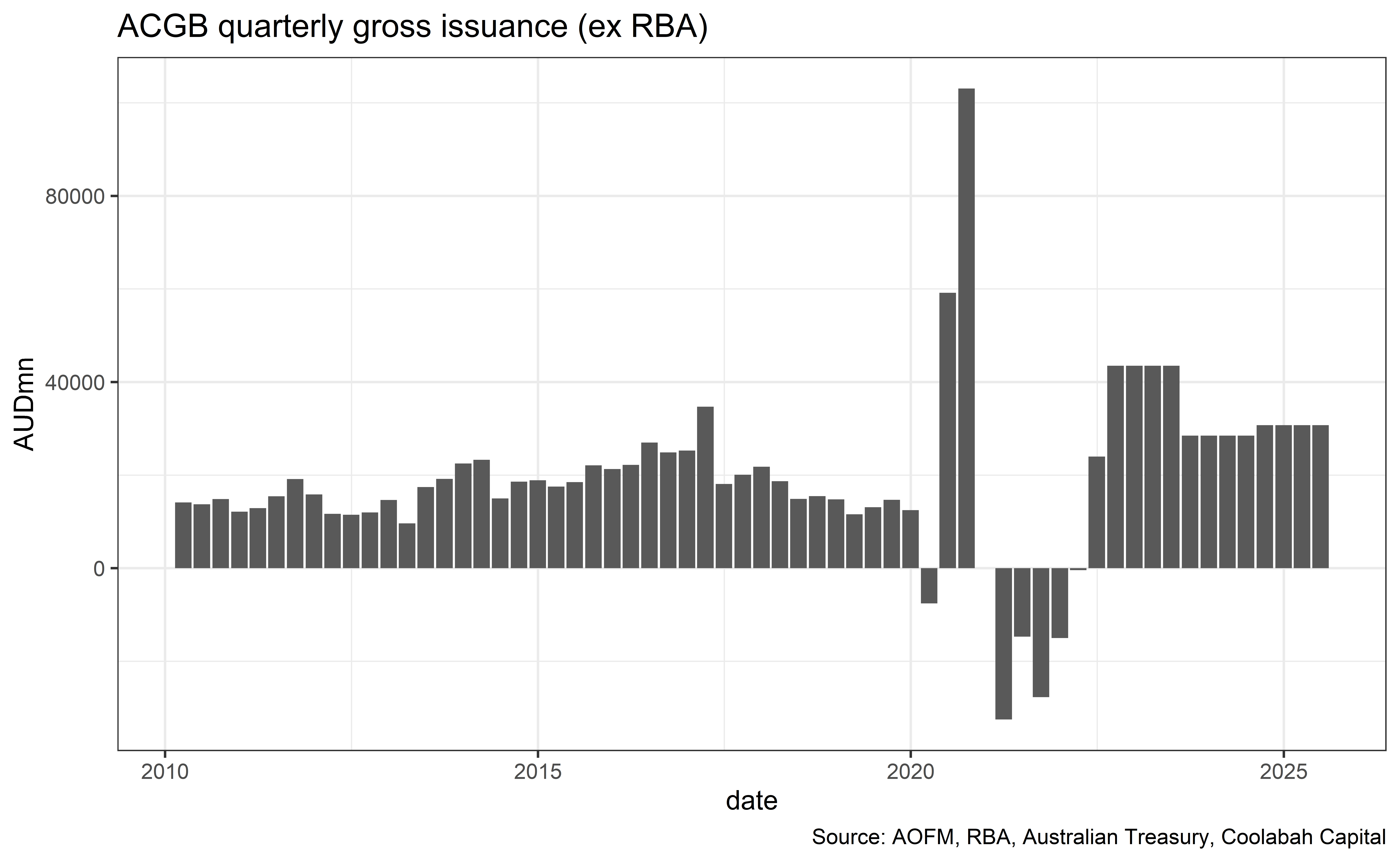
The change in gross issuance is large: for calendar year 2021, gross issuance excluding RBA purchases was minus $90 billion. This will rise by about $200 billion to $110 billion in 2022, and by a further $30 billion to $140 billion in calendar year 2023.
The exact profile from quarter to quarter will largely be determined by how the AOFM deals with maturities. In particular, the $85 billion of maturities in 2022-23 may be pre-funded, which may boost gross issuance in first half 2022, and mean that the AOFM can gross-issue less than $40 billion per quarter in second half 2022 and first half 2023.
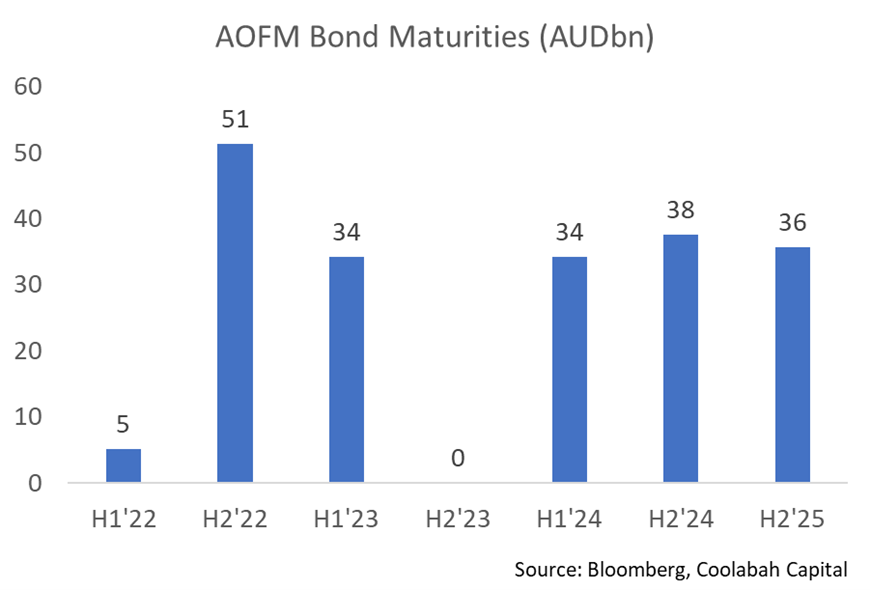
The increase in both the gross supply of bonds and their free float, and a smaller RBA balance sheet should contribute to the normalisation of repo financing conditions.
With this in mind, we think it’s more likely that repo rates rise than fall looking forward. This would tend to further tighten swap spreads. With this in mind, a long-term term target of 10bps seems reasonable.
Prepare for tighter spreads
Swap spreads can be thought of as combination of bank-credit and the bond-premium. We judge that the recent widening of swap spreads is due to the normalisation of bank credit and the very tight supply/demand conditions in the bond market caused by RBA bond buying.
The recent spike wider is hard to justify based on historical relationships; it very likely reflects a non-linear scarcity effect as the RBA’s share of the bond market grows.
Bond scarcity will change dramatically in 2022. There will be a large increase in gross supply as the RBA ends QE and the AOFM issues to fund large deficits and chunky bond maturities.
With this in mind, we expect repo conditions to normalise and swap spreads to tighten. We see fair value for 10 year swap spreads at 20bps just now, and expect that to decline to about 13bps over time, with risks to the downside if funding repo-financing conditions normalise more quickly than we have assumed (or become tight).
2 topics

Matt is a portfolio manager at Coolabah Capital, an asset manager than runs over $8 billion in fixed-income strategies. Matt has 17 years of experience on both the sell-side and buy-side. He spent most of his career (2008 to 2020) at UBS, the...

Matt is a portfolio manager at Coolabah Capital, an asset manager than runs over $8 billion in fixed-income strategies. Matt has 17 years of experience on both the sell-side and buy-side. He spent most of his career (2008 to 2020) at UBS, the...
